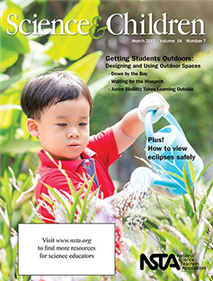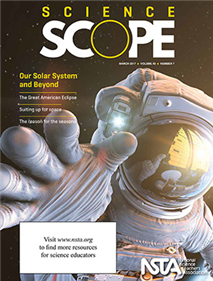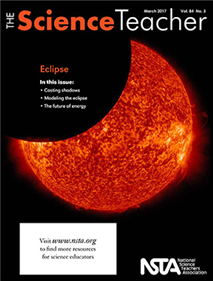All Resources
Journal Article
The resources of a nature center help second-grade students become experts in their local environment....
Journal Article
A kindergarten inquiry into life science occurs just outside the classroom window....
Journal Article
Junior BioBlitz Takes Learning Outside
Fourth graders learn about local biodiversity by working with local experts and nature enthusiasts....
Journal Article
An elementary science summer day camp uses high school mentors to get students excited about science....
Journal Article
Outstanding Science Trade Books for Students K-12
Recently published books selected by the Children’s Book Council and the National Science Teachers Association....
Journal Article
The Early Years: Exploring Biodiversity
This column discusses resources and science topics related to students in grades preK to 2. The objective in this month’s issue is to introduce children to the diversity of plant life in a given area through a plant scavenger hunt, and to guide chi...
Journal Article
Science and Children’s editor shares thoughts regarding the current issue....
Journal Article
The Poetry of Science: Citizen Science
Building literacy in playful, meaningful ways. Talking about this poem shows how regular people can join with scientists to study nature and observe patterns that provide significant data....
Journal Article
Teaching Through Trade Books: Adaptations for Survival
This column includes activities inspired by children’s literature. This month’s issue has students experience nature by examining how seeds are transported from one location to another or consider what it takes for organisms to survive in an envi...
Journal Article
Science 101: Does the Weather Affect Your Body?
This column provides background science information for elementary teachers. This month’s issue focuses on three major weather factors and how they affect the human body—temperature, humidity, and air pressure....
Journal Article
Science 102: Triple–Dog Dare Ya
This column shares exercises to challenge content knowledge. This month's issue presents a new challenge and answers the Raindrops Keep Falling challenge from last month....
Journal Article
Engineering Encounters: Building Technological Literacy With Philosophy and Nature of Technology
This column presents ideas and techniques to enhance your science teaching. In this issue the authors discuss a design project they have used with upper elementary students (grades 4–6). They note ways to engage students in thinking philosophically...
Journal Article
Challenge students to design a spacesuit that can maintain a safe temperature for astronauts who are working in space....
Journal Article
Use an NGSS-based lesson to help students understand what causes solar eclipses....
Journal Article
Skynet Junior Scholars: Authentic Astronomy for All, Including Deaf and Hard-of-Hearing Students
Build a portfolio of resources to use with students who have difficulty accessing the dense terminology and concepts often found in astronomy....
Journal Article
Moving Students Toward a More Accurate View of the Solar System
Use technology to collect data that students can use to model and better understand the solar system....
Journal Article
Confront students’ misconceptions about the Earth–Sun system with this collection of activities....
Journal Article
Outstanding Science Trade Books for Students K–12
Recently published books selected by the Children’s Book Council and the National Science Teachers Association....
Journal Article
From the Editor's Desk: When a Shadow Sheds Light
Science Scope’s editor shares thoughts regarding the current issue....
Journal Article
Commentary: Science Teachers as Community Eclipse Outreach Agents
An opinion piece about using science teachers as a link to the community....
Journal Article
Citizen Science: Out of this World Citizen Science—Sun, Space, and Your Mission: Starlight
This column highlights formal and informal science research projects that students can join and contribute to by gathering and sharing data. Mission: Starlight is a global experiment from the Royal Society of Chemistry, and as a citizen science proj...
Journal Article
Disequilibrium: The Bernoulli Bag
This column shows how to use discrepant events to confront misconceptions. Students explore pressure and the Bernoulli principle with a Bernoulli Bag....
Journal Article
Listserv Roundup: Four Stellar Modeling Resources for Those Who Teach About the Sun and Solar System
This column shares recent conversations taken from the NSTA listserv community about current science education topics. The author focuses on the NGSS crosscutting concept of Systems and System Models and uses the modeling resources shared on NSTA’s...
Journal Article
Scope on the Skies: Beyond Earth’s Orbit
This column focuses on astronomy throughout the year. This month’s issue discusses orbits and which planets can be seen in the sky right now....
Journal Article
Science for All: Helping Students Succeed by Preteaching Content-Area Vocabulary
This column shares strategies for increasing student engagement. In this article the authors discuss why teaching vocabulary is so important and explain how to identify key terms. They also introduce strategies that are effective for teaching vocabul...
Journal Article
Teacher to Teacher: Tackling Misconceptions About Seasons
This column provides practical advice from your peers. The author uses data and computer simulations to clear up misconceptions because students can study several locations in the Northern and Southern Hemispheres over a complete year in one class p...
Journal Article
The solar eclipse this August is an ideal opportunity to practice three-dimensional science learning....
Journal Article
Using various models and perspectives to help students visualize the solar eclipse....
Journal Article
Outstanding Science Trade Books for Students K–12
Books selected by the National Science Teachers Association/Children’s Book Council Review Panel...
Journal Article
Having students compare the effects of different energy sources on the environment....
Journal Article
Making formative assessment more responsive to student needs....
Journal Article
Editor's Corner: Standing in the Moon’s Shadow
The Science Teacher’s editor shares thoughts on the current issue....
Journal Article
Commentary: Become a Solar Eclipse Outreach Agent
As the public becomes aware of the August 21 solar eclipse, science teachers and students can step up to explain the eclipse and help prepare communities to safely view it....
Journal Article
Science 2.0: Help Students Become Global Collaborators
This column shares web tools that support learning. This month’s issue discusses the International Society for Technology in Education (ISTE) standards, which makes it possible for students to become global collaborators....
Journal Article
The Green Room: How Climate Change Affects Our Diet
This column focuses on making your teaching more environmentally friendly. This month’s issue discusses how climate change affects our food supply....
Journal Article
Focus on Physics: Teaching Physics as the Rules of Nature
This column helps teachers build an understanding of physical principles. This month's issue discusses the laws of nature....
Journal Article
Career of the Month: Fire Protection Engineer
This column shares interviews with professionals using science in the workplace. This month’s issue describes Nancy Pearce's career path to becoming a fire protection engineer....





